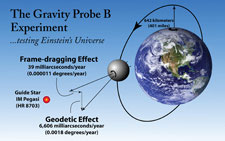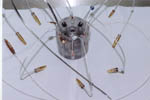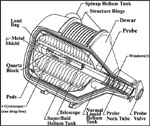WEEKLY HIGHLIGHTS FOR 8 OCTOBER 2004:
GRAVITY PROBE B MISSION UPDATE

At the end of Mission Week #25, GP-B is in its sixth week of science data collection.
The spacecraft continues to be in good health, flying drag-free around gyro
#1. All four gyros are digitally suspended and performing nominally. The spacecraft’s
roll rate remains at 0.7742 rpm (one revolution every 77.5 seconds). The Dewar
temperature is nominal (1.82 Kelvin), and the flow of helium, venting from
the Dewar through the micro thrusters remains within expected limits.
As noted in last week’s update, we have continued to monitor the performance
of gyro #3, which had been serving as the drag-free gyro until it suddenly
transitioned to analog backup suspension mode two weeks ago. At that time,
we quickly implemented a recovery plan, switching drag-free flight operations
to gyro #1 and reinstating digital suspension on gyro #3. It remained digitally
suspended all last week until last Friday, 1 October 2004, when it once again
transitioned into analog backup mode. This past Monday, 4 October 2004, we
re-suspended gyro #3. Subsequently, we changed the Gyro Suspension System (GSS)
bridge setting for this gyro to the high-level excitation mode used during
gyro spin-up to increase the signal-to-noise ratio of this gyro’s position
readout. The GSS team will continue to monitor the performance of this gyro,
and they are preparing to test several hypotheses regarding the root cause
of this gyro’s loss of digital suspension.

Last week, we also reported detecting oscillations in the drag-free control
force, which we suspect were caused by a sympathetic resonance between the
ATC drag-free control efforts and a sloshing wave on the surface of the now
reduced superfluid helium in the Dewar. We adjusted the ATC drag-free suspension
parameters to de-tune this harmonic coupling, and the oscillations disappeared
for most of last week, but last Friday, they began to re-appear. We have since
reduced the gain in the drag-free controller to its initial level, prior to
the appearance of these oscillations, and this seems to have mitigated these
oscillations. Following is a more detailed explanation of this suspected harmonic
resonance phenomenon, provided by our GP-B cryogenic expert, Mike Taber. 
GP-B recently experienced a minor instability, characterized by excessive
thruster venting and a slowly rotating force transverse to the roll direction.
This force oscillation was observed by the suspension system of all four gyros
and had a period of approximately 220 seconds (3.7 minutes). At the time this
occurred, the system was in "drag-free" mode, where the control effort
needed to center gyro #1 was being minimized by the helium thrusters. This
is normal operation in science mode, wherein the space vehicle is being flown
in such a way as to minimize the suspension forces and torques that can perturb
the gyro spin direction. As a precautionary measure, in response to this oscillation,
the drag-free control system was commanded off. The oscillation was then observed
to slowly decay over a period of about six hours.
 The initial assessment of this phenomenon was that it was due to a slosh instability
in the liquid helium. The helium in the main tank exists in two phases: liquid
and vapor. Since the space vehicle is slowly rolling, centrifugal force causes
the denser liquid to reside near the outer wall of the main tank with the vapor
forming a bubble at the center. Normally, the liquid rotates as a solid body
with the rest of the vehicle. However, if excited, it is dynamically possible
for a surface wave to form at the liquid-vapor interface that can propagate
circumferentially. The fact that the oscillation persisted, but then slowly
decayed after the drag-free control was turned off, supports this scenario.
The energy to build up and sustain the wave was supplied by the drag-free system
reacting to the force of the propagating wave with an appropriate phase shift.
A subsequent examination of telemetry data indicated that this phenomenon actually
started when the gain of the drag-free controller was doubled some time ago,
but the amplitude was too small for it to be readily apparent. Ten days (and
a number of events) actually passed before the oscillation grew sufficiently
large that it was noted in the Attitude and Translation Control (ATC) system
and Dewar data. The drag-free controller gain has since been reduced back to
its original value. There is no indication that any of these events had any
adverse impact on the GP-B experiment.
The initial assessment of this phenomenon was that it was due to a slosh instability
in the liquid helium. The helium in the main tank exists in two phases: liquid
and vapor. Since the space vehicle is slowly rolling, centrifugal force causes
the denser liquid to reside near the outer wall of the main tank with the vapor
forming a bubble at the center. Normally, the liquid rotates as a solid body
with the rest of the vehicle. However, if excited, it is dynamically possible
for a surface wave to form at the liquid-vapor interface that can propagate
circumferentially. The fact that the oscillation persisted, but then slowly
decayed after the drag-free control was turned off, supports this scenario.
The energy to build up and sustain the wave was supplied by the drag-free system
reacting to the force of the propagating wave with an appropriate phase shift.
A subsequent examination of telemetry data indicated that this phenomenon actually
started when the gain of the drag-free controller was doubled some time ago,
but the amplitude was too small for it to be readily apparent. Ten days (and
a number of events) actually passed before the oscillation grew sufficiently
large that it was noted in the Attitude and Translation Control (ATC) system
and Dewar data. The drag-free controller gain has since been reduced back to
its original value. There is no indication that any of these events had any
adverse impact on the GP-B experiment.
Images & photos: The diagrams of the GP-B experimental procedure, the photo of a complete gyro housing, including all of its wires and fiber optic cables, and the cutaway drawing of the Dewar are from the GP-B Image Archives here at Stanford. The photo of the Dewar was taken by photographer Russ Underwood of Lockeed Martin Missiles & Space Company. Click on the thumbnails to view these images at full size.
Please Note: We will continue updating these highlights and sending out the GP-B email update on a weekly basis—at least through the first few weeks of the Science Phase of the mission. As mission operations become more routine, we may reduce the frequency of these updates to biweekly. However, from time to time, we intend to post special reports and special updates, as warranted by mission events.
SWISS AMATEUR ASTRONOMER PHOTOGRAPHS GP-B GP-B SPACECRAFT IN ORBIT WITH GUIDE STAR IM PEGASI
To the right, is a thumbnail of a photograph of the GP-B spacecraft in orbit, along with the guide star, IM Pegasi. (Click on the thumbnail to view the photo at full size.) The photo was taken and emailed to us by Stefano Sposetti, a Swiss physics teacher and amateur astronomer. Stefano used a 40cm newtonian telescope, with a CCD camera and 20mm wide field lens attached to make this photo. He then sent us the two versions shown — the normal (black sky) version on the right, and an inverse version in which the constellation, Pegasus, the guide star IM Pegasi, and the path of the GP-B spacecraft are highlighted for easy identification on the left.

We are grateful to Stefano for sending us this wonderful photo. You can view other astronomical photos that he has taken on his Web page: http://aida.astronomie.info/sposetti. Following is Stefano's description of his photo:
In this picture one can see the quite dim GP-B satellite traveling from North (up) to South (down) direction. The bold line in the right part of the left image represents the satellite trail just before entering the earth shadow. (Every satellite becomes visible because it reflects the sunlight). The connecting lines show the constellation Pegasus. The small circle around the star is IM Pegasi, the guide star used by the spacecraft's telescope in his experiment! GP-B is a circumpolar satellite following a free fall trajectory about 640km above the earth surface. From my location the satellite passed that night at a maximum elevation of 87degrees, thus not exactly overhead. The brightness of the satellite was between 3mag and 4mag. The Moon, about in the last quarter phase, illuminated the sky and was a drawback for having a good signal/noise ratio of the satellite trace. I took this 60-seconds black and white CCD picture with a 20mm,f/2.8 lens on august 6 centered at 01:19:00 UT. North is up, East is left.
More links on recent topics
- Track the satellite in the sky
- Photo, video & and news links
- Build a paper model of the GP-B Spacecraft
- Following the mission online
- Our mailing list - receive the weekly highlights via email
- The GP-B Launch Companion in Adobe Acrobat PDF format. Please note: this file is 1.6 MB, so it may take awhile to download if you have a slow Internet connection.
Previous Highlight
Index of Highlights
